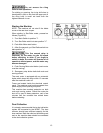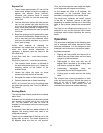
17
Miter Fence
The flat T-nut which holds the vertical rod of the
clamp is factory set and must remain in its
position to make the angle scale correspond.
1. To set the required angle, loosen the rod (A,
Figure 32) with the provided pin as shown.
Loosen the large lever (B, Figure 32).
2. To slide the fence (C, Figure 32) toward or
away from the saw blade, unlock the two
smaller levers.
3. Reading the angle is done at the edge of the
aluminum bracket. An adjustable stop can
be mounted to the miter fence as shown in
Figure 32, for making multiple cuts of the
same length.
Rip Fence
1. To move the rip fence, shown in Figure 33,
turn the micro-adjust gear counterclockwise,
and lift the handle. The fence should slide
freely on the guide bar.
2. To lock the fence in position, push the
handle down and tighten the micro-adjust
gear by turning it clockwise.
3. Micro-adjustment is achieved by locking the
micro-adjust gear, by holding the handle in
the upright position, and by turning the
micro-adjust knob.
4. After adjustment, push handle down to lock
the fence in place.
NOTE: When cutting small workpieces with the
saw blade tilted at 45 degrees, the aluminum rip
fence should be used in the low position:
1. Loosen the aluminum fence lock, slide the
fence off and slide it back on in the low
position, as shown in Figure 34.
2. Tighten the aluminum fence lock.
When cutting solid wood using the rip fence, to
avoid the wood getting stuck between the fence
and riving knife (which can result in a dangerous
kickback) reposition the aluminum fence so that
its end protrudes just past the end of the riving
knife.
Rip Fence Scale Calibration
Each time a new blade is mounted, the rip fence
scale has to be calibrated to the new blade.
With the fence at a convenient spot, cut a
sample and measure its exact width.
Figure 32
Figure 33
Figure 34


















